Mr Eazi, the Curator
Written by ABR on 11/10/2023
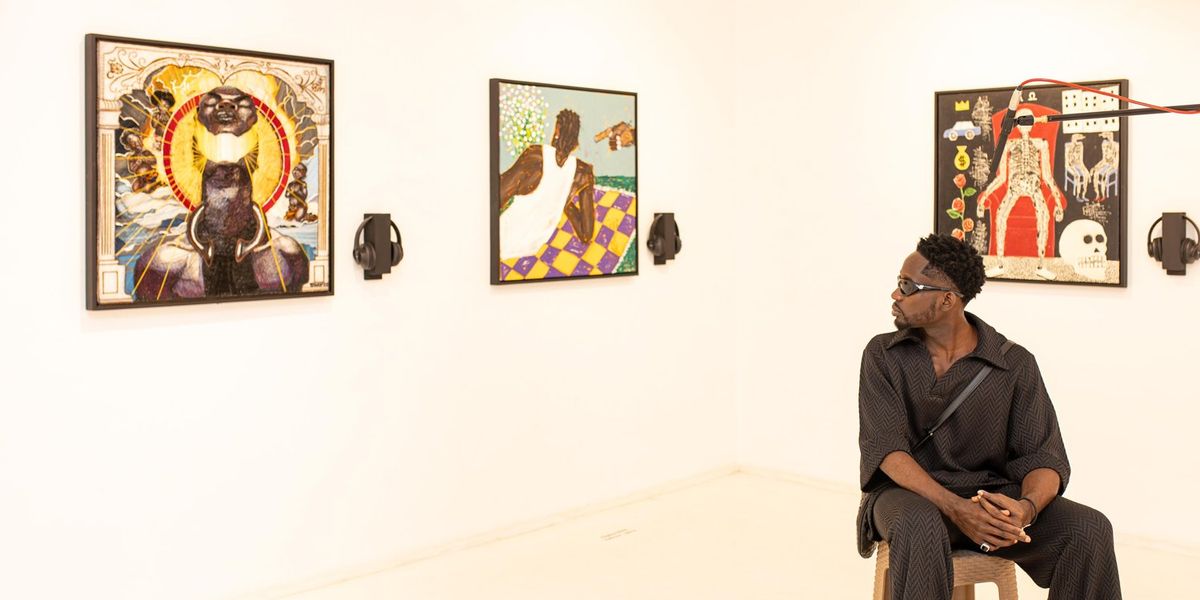
Mr Eazi used to be someone who didn’t particularly care for art. “It’s not like I would see something and not appreciate it,” he tells OkayAfrica. It’s more that, for him, the musician born as Oluwatosin Oluwole Ajibade, there was no real interest in it beyond that momentary interaction. But, over the course of the past ten years, while releasing dozens of hit singles and mixtapes, he found himself becoming more intrigued by art, working on covers for his albums and seeing Peter “Poka Arts” Asamoah create the music video animations.
In 2020, his interest was stoked even further, when he visited the Noldor Artist Residency at the Institute Museum of Ghana, and took in the work of rising young artist Emmanuel Taku.
As Eazi explains it, learning about how the artist allowed his work to be informed by whatever came to him in the moment felt like he had a new way of understanding art – one that made him think of how he creates his music. “The instrumental is like a blank canvas, and the first brushstrokes are like melodies that start to form,” he says. “And in the end, there’s a song that started from nothing. From then, I started to appreciate art in that way, and see the magic of creativity.”
Now, he confidently declares, “I’m a new lover of art. I’m constantly learning, and I’m just like a kid being in a candy store.” He’s sharing the sweetness of his newfound passion with his fans, through the upcoming release of his debut studio album, The Evil Genius, on October 27th.
The album combines sixteen tracks with corresponding artworks by thirteen artists from eight different countries. And Eazi’s been taking an exhibition of the artworks on the road. First, it went to Gallery 1957 in Accra, and this week, it’ll open in London at the 1-54 Contemporary Art Fair. More dates are expected to be announced in the near future.
“The barrier to entry – and when I say entry, I mean appreciation and engagement of art – has now dropped,” says Eazi. “That’s the beautiful thing about this project. When I did the exhibition in Accra, I could see people like myself, people who didn’t think they cared about art, experiencing art in this way without feeling it’s still so grand, or without being in a museum. Experiencing it in a way that’s very non-gated, is beautiful.”
Eazi spoke with OkayAfrica about some of the artists he worked with for the exhibition and his album.
The interview below has been edited and condensed for length and clarity.
Patricorel (Benin)
Created pieces for “Òròkórò,” “Good Lovin’” and “Legalize.”
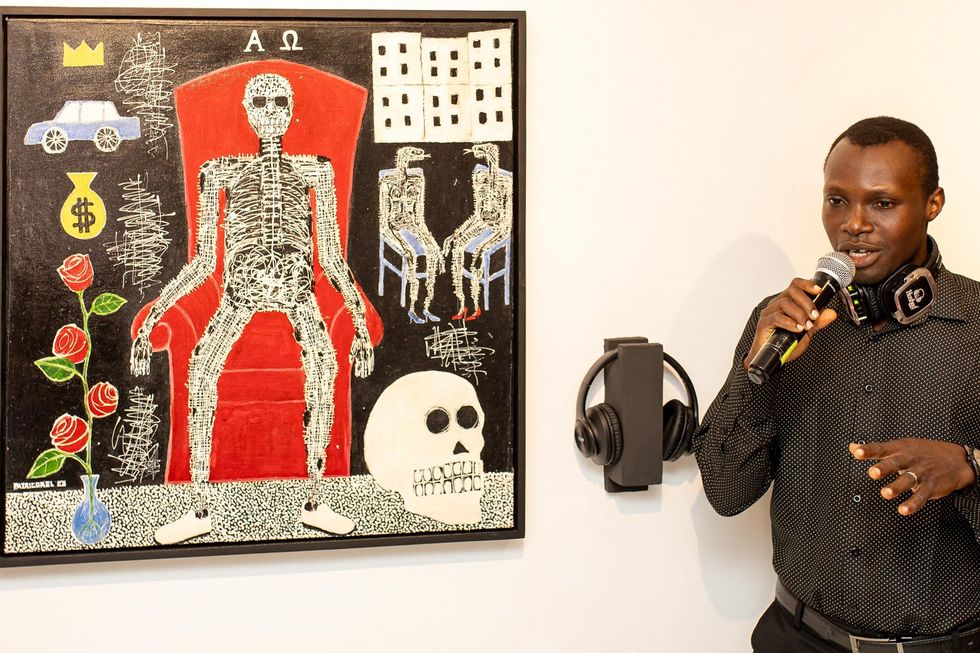
Patricorel speaks to guests at the Accra opening of ‘The Evil Genius.’Photo courtesy of the artist/Choplife.
Mr Eazi: I saw his work, and once I did, I just knew he was describing love in a way I’ve never seen love being described. When people describe love, it’s always, like, butterflies, roses, and beauty, and he was using skeletons of a man and a woman. Weirdly, I thought that was so beautiful. I was like, Why do I think this is so beautiful? And I still think that it’s so beautiful. It’s a different way of telling a love story. I think the whole concept of two people coming together to decide to be together and to be together on this life’s journey is a miracle. And that’s is beautiful. It’s not all fun and games, and [Patricorel’s work] is a true reflection of the realities of commitment.
Samuel Tete-Katchan (Togo/Ghana)
Created pieces for “Exit” and “Fefe Ne Fefe.”
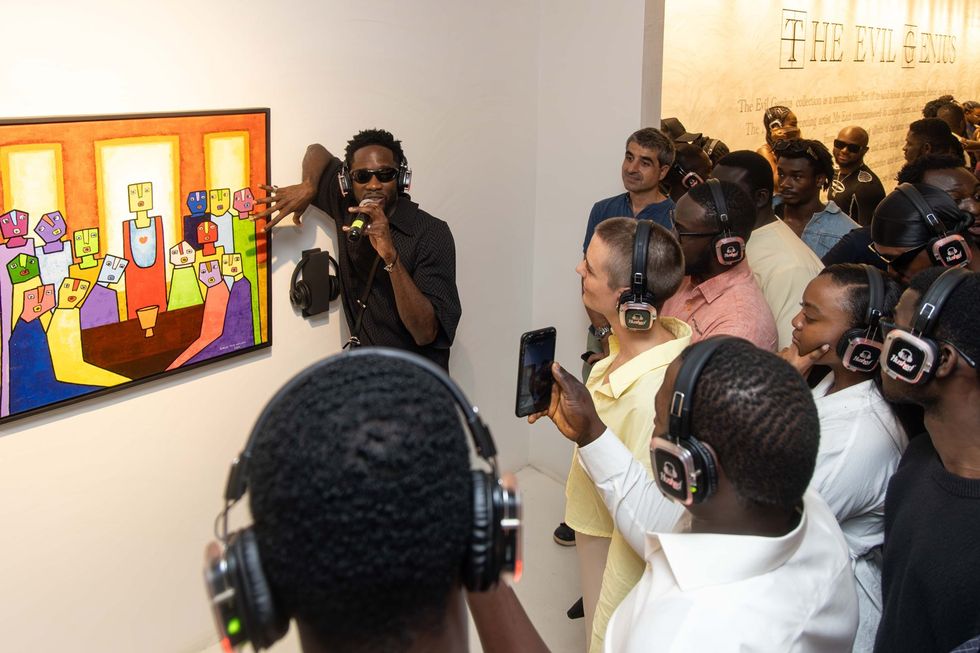
Mr Eazi talks to guests at the Accra opening of ‘The Evil Genius’ about Samuel Tete-Katchan’s art.Photo courtesy of the artist/Choplife.
Mr Eazi: When I sent him the song, and he gave me his feedback, he was describing and telling me things that were in my head when I was making the song, but I had not even said [them] to myself. And I thought it was just so beautiful. Because in the “Exit” song, I was speaking to my feeling – whether true or not, because my truth might not be your truth and how I see things might not be how you see things – of being betrayed by people that were close to me. That’s what I was singing about; that journey of fellowship with people and then feeling isolated.
[Tete-Katchan] brought that to life with the Last Supper. When we were speaking, we were talking about [the Psalm] prepare a table before me in the presence of my enemies, and how you could be in the presence of your enemies and still bring forth so much light. There would still be so much light on you that you even drink wine, your cup is running over. It means you’re so comfortable, you’re radiating confidence, even around people who don’t like you.
Tesprit (Togo)
Created the piece for “Mandela.”
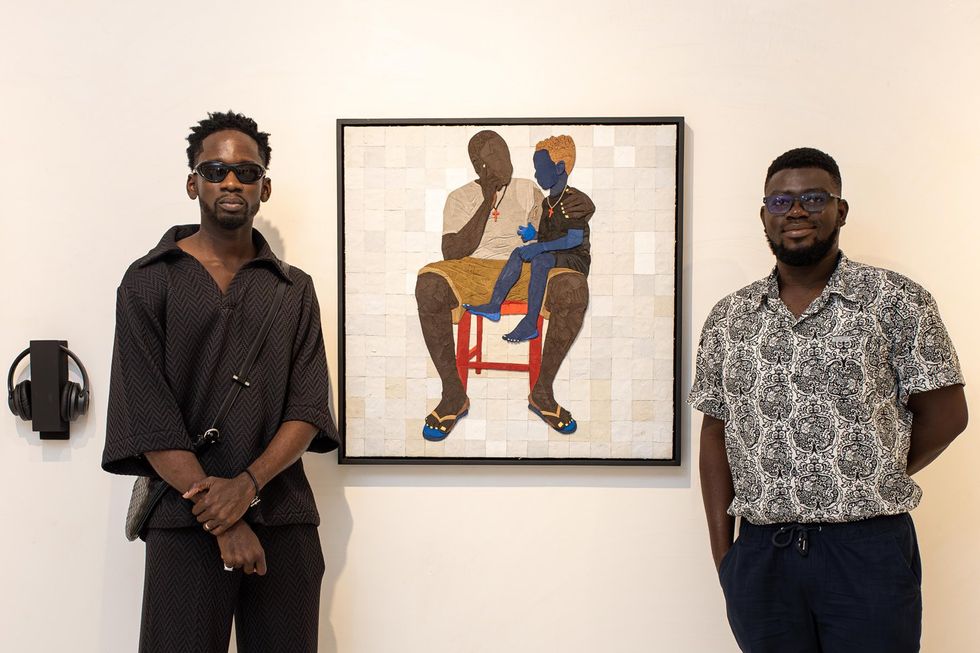
Mr Eazi and Tesprit at the Accra opening of ‘The Evil Genius.’Photo courtesy of the artist/Choplife.
I like his mode of using waste [materials] and how it brings life into things that are so dead. I made “Mandela” at a time when I was not fully acknowledging the role my dad had in my life. It’s very easy to just think [of] your mom because she’s the one that was always around. My dad was around but he was working, so she was more around than him. I think a boy child always has a connection with their mom. I’m a mommy’s boy. But in my subconscious, I was aware of the sacrifices my dad had made, and everything I am today, I owe as much to my dad as to my mom. Growing up, I never realized how much choice a father could have, and the things he had to deprive himself of – his personal desires – to provide for us. Tesprit brings that to life with the image of Mandela advising a kid, carrying a kid.
Elangwe Sesse (Cameroon/USA)
Created the piece for “Chop Time, No Friend.”
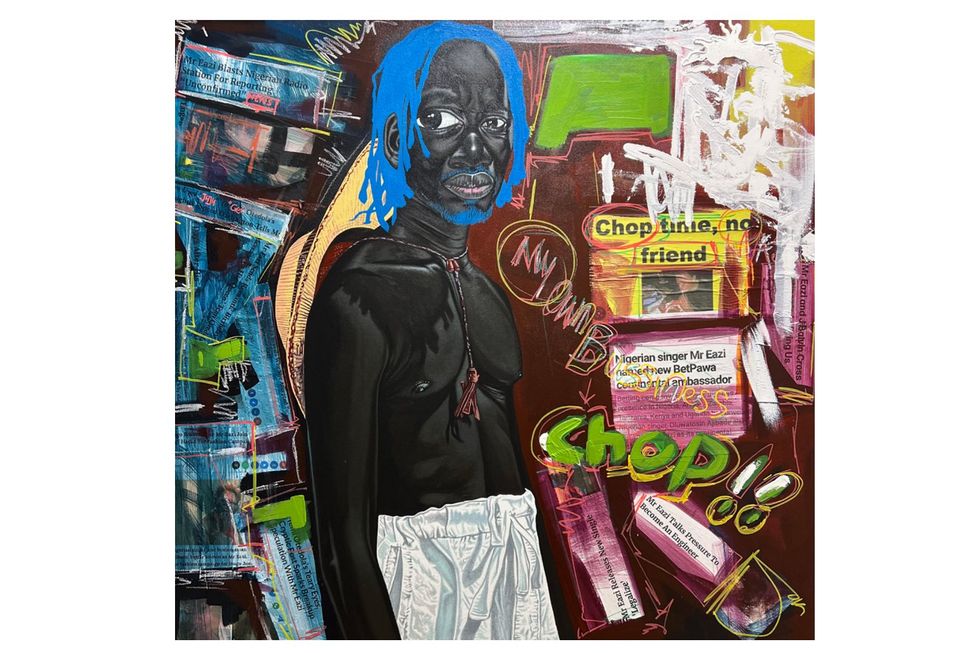
Elangwe Sesse’s painted his interpretation of Mr Eazi’s “Chop Time, No Friend.”Photo courtesy of the artist/Choplife.
Mr Eazi: Funny enough, the other day, I was doing a walkthrough, and I was really looking at the piece again. And I saw that there was so much work, so much research that went into it. Every time I look at it, I see something different, and just how broad the work is. I almost didn’t want to show it. So it wasn’t supposed to be shown. I had, like, taken it off. Then I was like, Okay, I’m being too selfish, and I put it back in.
Sandra Seghir (Togo/Senegal)
Created the piece for “Zuzuakathe.”
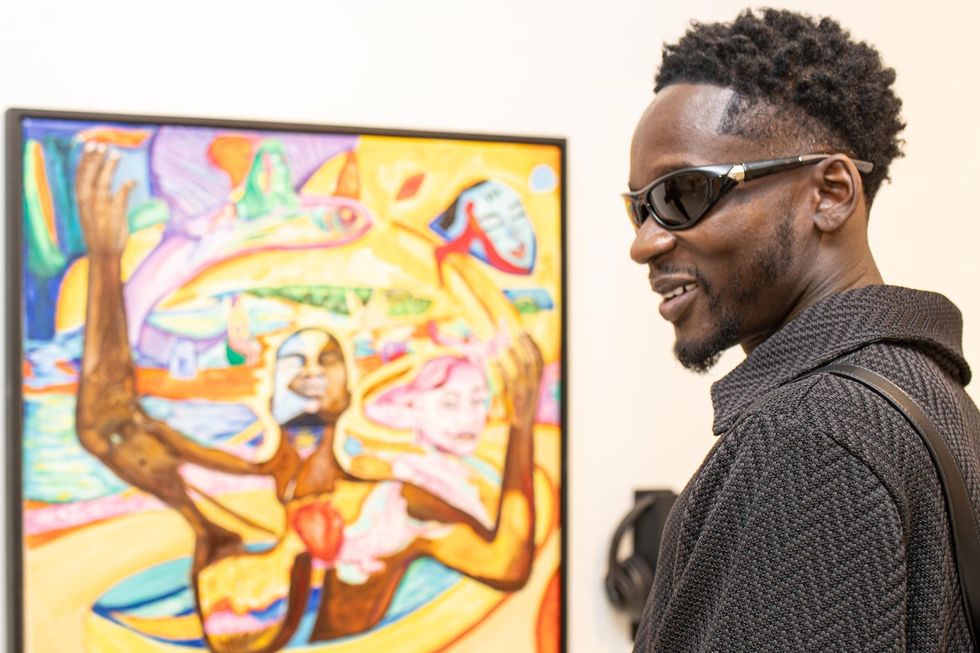
Mr Eazi and Sandra Seghir’s painting for “Zuzukathe.”Photo courtesy of the artist/Choplife.
Mr Eazi: When I was sitting with [Sandra] talking about “Zuzuakathe,” my first impression of her was that she was too deep. I’m not that deep! But, you look at that piece and you see my image there. There’s no picture of me showing that kind of expression. I think it’s more than a facial expression; I think it’s more being naked in a way of, like, no ego, everything [drawn] out of me. The intensity with which she brushes, with the different colors, like the pink coming out of my heart, it’s almost like streams of emotion coming out of me. I don’t know how she was able to capture that, the essence of “Zuzuakathe,” because “Zuzuakathe” is about a groaning of thanksgiving that you cannot say with words. Seeing this gibberish expression on the canvas is lovely.
Kufa Makwavarara (Zimbabwe/South Africa)
Created the piece for “We Dey.”
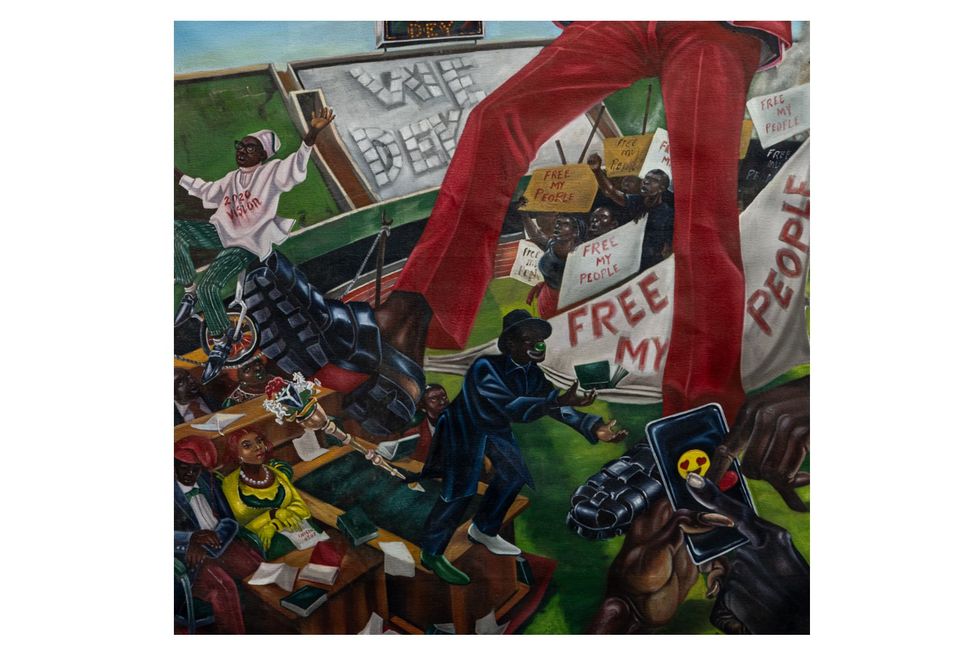
Zimbabwean artist Kufa Makwavarara painted his take on Mr Eazi’s song, “We Dey.”Photo courtesy of the artist/Choplife.
I went to an art fair in Cape Town, and I saw his work. I immediately knew that this is a person to paint “We Dey.” [I was] told he was an artist from Zim, and I was, like, ‘Okay, let’s contact him anyway,’ and it turned out he was actually in Cape Town. And he came with his brother to my house. He’s the only artist that heard the entire album. He sat in my house, and we played the entire album. And he loved “We Dey.” I said, ‘This is the one I want you to paint.’
He ended up painting the most political piece – the only political piece in the project. But it’s not in a way where it is too intense. It’s still in the same playful way that I am, because I only talk about politics just slightly in the song. He was able to bring that out. It’s like he almost kind of knew that, ‘Okay, he wants to talk about politics, but he doesn’t want to talk about politics; he wants to talk about it in a way where it doesn’t seem like the news.’ And he was able to represent that. It’s all about the people, the citizens, saying, ‘We are here.’
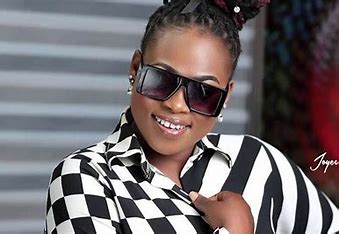

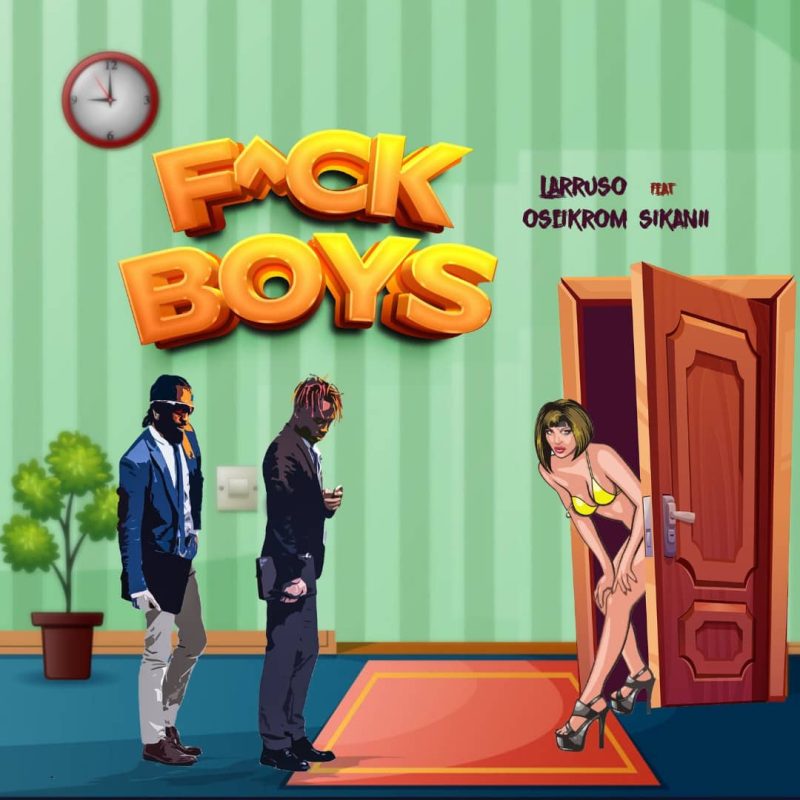
 ABR Group
ABR Group